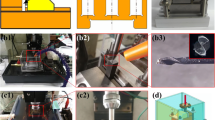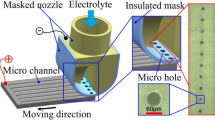Abstract
A method of fabricating micro-core on hard materials by electro-discharge machining (EDM) with multi-station narrow slit electrode was proposed. Instead of changing electrodes traditionally, the method of transforming the electrode station was applied, and the positioning error could be avoided. With the narrow slit structure of the electrode, the discharge debris could be excreted easily and the high depth-to-width ratio of micro-core could be fabricated. NAK80 was selected as the core material, while copper-tungsten alloy (70 % W) as the electrode material to carry out the fundamental experiments in which the relationship between the number of electrode stations and forming accuracy of micro-core was researched. The results demonstrate that using four electrode stations, the dimensional precision is within 3 μm, the root radius is within 10 μm, and the surface roughness is Ra 0.198 μm, and all this can be satisfied with the demand of molding for microfluidic chip. On the basis of the fundamental experiment results, a variable section micro-core was manufactured. The machining results show that the forming accuracy of the convex becomes worse with the decrease of the forming convex height. This phenomenon was analyzed in EDM principle and the error reflection mechanism.
Similar content being viewed by others
References
Cao Y, Bontrager-Singer J, Zhu L (2015) A 3D microfluidic device fabrication method using thermopress bonding with multiple layers of polystyrene film. J Micromech Microeng. doi:10.1088/0960-1317/25/6/065005
Song MC, Liu Y, Zhu TL, Zhang CZ, Liu JS, Liu C (2011) Analysis of injection molding defects for microfluidic chip. J Mech Eng 47:33–38
Marasso SL, Canavese G, Cocuzza M (2011) Cost efficient master fabrication process on copper substrates. Microelectron Eng 88:2322–2324
Ma YL, Liu WK, Liu C, Du L (2013) Application of UV-LIGA technology to machining micro-injection mold cavity of cell culture device. Opt Precis Eng 21:1228–1233
Leo Kumar SP, Jerald J, Kumanan S, Prabakaran R (2014) A review on current research aspects in tool-based micromachining processes. Mater Manuf Process 29:1291–1337
Fonda P, Nakamoto K, Heidari A, Yang HA, Horsley DA, Lin L, Yamazaki K (2013) A study on the optimal fabrication method for micro-scale gyroscopes using a hybrid process consisting of electric discharge machining, chemical etching or micro-mechanical milling. CIRP Ann Manuf Technol 62:183–186
Xu B, Wu XY, Ling SQ, Luo F, Du CL, Sun XQ (2013) Fabrication of 3D metal micro-mold based on femtosecond laser cutting and micro-electric resistance slip welding. Int J Adv Manuf Technol 66:601–609
Zhong JM, Wu XY, Xu B, Li JB, Luo F, Cheng R, Ruan SC (2015) Laminated fabrication of micro-stepped gear mold based on WEDM and thermal diffusion welding. Int J Adv Manuf Technol 78:1233–1240
Yan J, Kaneko T, Uchida K, Yoshihara N, Kuriyagawa T (2010) Fabricating microgrooves with varied cross-sections by electrodischarge machining. Int J Adv Manuf Technol 50:991–1002
Shiu PP, Knopf KG, Ostojic M (2010) Fabrication of metallic micromolds by laser and electro-discharge micromachining. Microsys Technol 16:477–485
Yu ZY, Masuzawa T, Fujino M (1998) Micro-EDM for three-dimensional cavities—development of uniform wear method. CIRP Ann Manuf Technol 47:169–172
Jahan MP, Wong YS, Rahman M (2009) A study on the fine-finish die-sinking micro-EDM of tungsten carbide using different electrode materials. J Mater Process Technol 209:3956–3967
Sánchez HT, Estrems M, Faura F (2011) Development of an inversion model for establishing EDM input parameters to satisfy material removal rate, electrode wear ratio and surface roughness. Int J Adv Manuf Technol 57:189–201
Kiyak M, Aldemir BE, Altan E (2015) Effects of discharge energy density on wear rate and surface roughness in EDM. Int J Adv Manuf Technol 79:513–518
Nguyen VQ, Duong TH, Kim HC (2015) Precision micro EDM based on real-time monitoring and electrode wear compensation. Int J Adv Manuf Technol. doi:10.1007/s00170-015-6964-y
Yan MT, Lin SS (2011) Process planning and electrode wear compensation for 3D micro-EDM. T Int J Adv Manuf Technol 53:209–219
Abdulkareem S, Khan AA, Konneh M (2015) Reducing electrode wear ratio using cryogenic cooling during electrical discharge machining. Int J Adv Manuf Technol 45:1146–1151
Bissacco G, Valentincic J, Hansen HN, Wiwe BD (2010) Towards the effective tool wear control in micro-EDM milling. Int J Adv Manuf Technol 47:3–9
Author information
Authors and Affiliations
Corresponding author
Rights and permissions
About this article
Cite this article
Song, M.C., Liu, Y. & Li, W.M. Fabricating micro-core by EDM with multi-station narrow slit electrode. Int J Adv Manuf Technol 88, 3507–3514 (2017). https://doi.org/10.1007/s00170-016-9061-y
Received:
Accepted:
Published:
Issue Date:
DOI: https://doi.org/10.1007/s00170-016-9061-y




